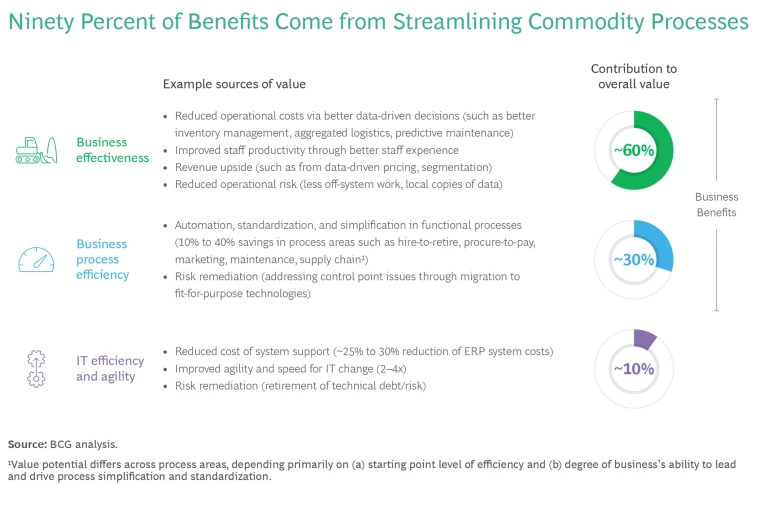Enterprise solutions have changed significantly over the last 20 years; however, the way most organizations implement them has not. This is driving significant waste and delays. Product and platform vendors have developed highly configurable, out-of-the box, cloud-based solutions, but organizations are still engaging in unnecessary customization. Unfortunately, the track record for successful implementation of these projects is poor, with less than half running on time or on budget.
Our experience shows that there is a way to realize more value, faster, and with lower risk—and some organizations are starting to get this right. The secret is to better align vendor delivery incentives and to leverage the built-in capabilities of these enterprise solutions. We expect Generative AI and other forms of automation will also help to accelerate the process. It is imperative that companies improve their approach to implementation given that spending on enterprise digital transformation efforts is predicted to grow from $380 billion to $540 billion annually over the next four years.
Old Deployment Methods Persist
The scope and features of enterprise solutions continue to expand across all industries and functions, making many legacy ways of working obsolete and much more costly to run. Up to 90% of business value from these new implementations comes from streamlining legacy ways of working. (See the exhibit.) Moreover, these solutions are faster to deploy with smaller teams thanks to their modularity, configurability, cloud-based deployment, and no-code approach. Generative AI and other forms of automation are turbocharging this trend by automating entire sections of the software development lifecycle.

But many organizations miss out on these benefits because, instead of streamlining legacy ways of working, they end up replicating current complexity in a new tech stack. They need large teams of engineers to implement excessive customization, often under the guise of being “business led.”
This approach might have made sense in the 1990s, when out-of-the-box solutions were limited. But given the built-in capabilities of today’s solutions, this approach simply slows down implementations and raises costs at a time when speed and efficiency are critical. These new built-in capabilities, combined with GenAI’s power to drive faster and higher value implementations, will increase the competitive peril for those that continue with the old, highly customized approach.
A Better Approach to Implementation
While GenAI applications and methods are still maturing, the directional impact is already very clear. Organizations that stick with the old formula of multi-year platform implementations will be outmaneuvered by those willing to test, learn, and adapt. The most advanced enterprises have adopted four principles to guide their implementations.
Use out-of-the-box solutions, avoid custom code
As noted, out-of-the-box, enterprise solutions are becoming increasingly common, and they offer more reusable patterns, templates, workflows, and data models. Organizations should lean into these. Instead of gathering detailed requirements based on the complexity of the current state or some hypothetical future state, organizations should adapt their processes and ways of working to the solutions available and keep customization to a minimum.
In many cases, organizations can actually address “custom” requirements with existing out-of-the-box functionality, configurations, add-ons, value-added services, or features. Often, it’s just a matter of leveraging the expertise of the product architects. True customization should be limited to when the existing functionality is not available, where there is genuine competitive advantage, and the business value at stake materially exceeds the cost of development and integration.
In our experience, an outside-in perspective is very valuable in identifying what truly drives competitive advantage and the cost-benefit trade-off. The reality is that, in most cases, what organizations perceive as essential, unique requirements actually offer little or no value over industry-standard best practices.
To illustrate this first implementation principle, consider the example of a state public sector entity that recently undertook a CRM implementation. Instead of seizing the opportunity to simplify operations, junior business managers were trying to replicate legacy ways of working in the new CRM solution, resulting in a highly bespoke version of the base product. Fortunately, senior leaders realized in time that the implementation was veering off track. They began leveraging the product architect’s expertise more systematically and engaged a boutique engineering partner to help make better use of out-of-the-box capabilities. Leaders also ensured that frontline staff were more closely involved to help identify where and how to simplify processes.
Align incentives, avoid time and materials contracts
Organizations should avoid time and materials contracts because they incentivize implementation partners to propose more bespoke solutions, complexity, and architectures. These require more engineering, testing, time, and costs. Even when organizations put fixed time and outcome contracts in place, they should be wary of vendor incentives that extend beyond the build phase. If a vendor stands to benefit from managed service contracts, they might overcomplicate solutions and create longer term dependency.
This was the predicament the state public sector entity faced when trying to implement the CRM solution. Time and materials contracts did not include strong incentives for vendors to deliver on time, resulting in the vendor accepting ongoing delays rather than working toward timely delivery. In response, leaders committed to fixed time and cost contracts that incentivized vendors to challenge complex business requirements, ferret out low-value customization requests, and use out-of-the-box capabilities whenever possible.
Insist on knowledge transfer, avoid dependency
To reduce future vendor dependency, organizations should require that vendors upskill and equip their in-house IT team to run, maintain, and support solutions. Another way to help break vendor dependency is to separate build and run contracts.
In the case of our public sector client, the number of bespoke requests combined with the vendor’s willingness to accommodate these requests meant that a gap was growing between what the vendor was building and what the client could support. In response, leaders adjusted the plan and deliverables to include training and change management to ensure internal teams could support the business from day one and maintain stable operations going forward.
Engage the C-suite for decisions and authority, avoid delays
Many enterprise platform programs fail because senior leaders are not sufficiently engaged during the implementation to make fast, pragmatic decisions—often resulting in rework, waste, and delays. Engaging senior leaders early helps to align the program vision and also creates an environment to pursue transformational change. Without this clear leadership, middle management tends to be risk averse and often asks vendors to build “what they have today” into the new solution.
The public sector entity had to cope with this very issue. The project began with a disjointed structure across business and tech, with decision-makers too junior to make fully informed choices. This led to constant reworking, delays, and poorly managed business expectations. To remedy the problem, senior executives joined the project and focused on rethinking ways of working to improve efficiencies. They also de-prioritized “nice-to-have” features and focused on critical go-live features to accelerate time to value.
To stay competitive in today’s marketplace, organizations need to free themselves from the constraints of the “old way” of implementing enterprise solutions.
Positioning the Organization for Success
By following these four implementation principles, the public sector entity successfully replaced a more than 20-year-old CRM system with a user-friendly platform that could respond to requests twice as fast as the old system. The transition to the new platform, including data migration and decommissioning the legacy platform, occurred within 90 days.
Moreover, the organization has built agility into its delivery model. New features can be added monthly using a sprint-based methodology. Previously, they could add new features quarterly at best, and these add-ons usually addressed stability concerns on the platform rather than new user features.
Incorporating these principles into an implementation has clear advantages, but it is a demanding approach. Organizations need to ask themselves: Are our executives really interested in doing things differently? Are they up for the challenge to be hands-on, and can they resist the temptation to customize?
It’s a radically different approach, but organizations need to commit to faster enterprise implementations to stay competitive in today’s marketplace. When freed of the constraints of the “old way” of implementing enterprise solutions, leaders will enjoy greater reliability, accountability, and value from their projects.







